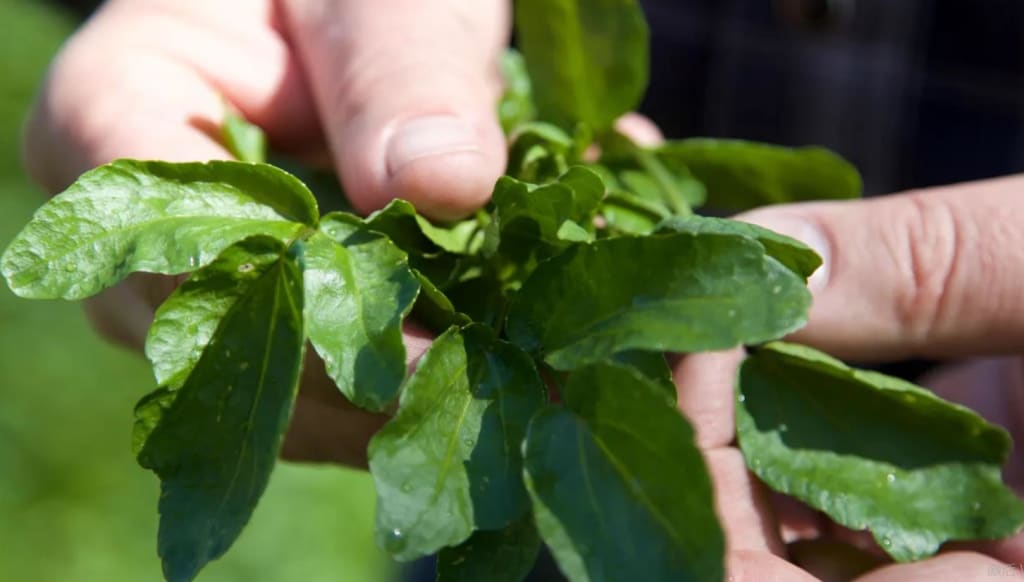England's 'nose-twisting' superfood salad
An English market town celebrates the punchy plant with an extravagant annual watercress festival and pristine heritage railway.

It was a sunny July day and I felt as though I was standing in a 19th-Century film set. The whistle of the steam train sounded as I waited on the perfectly preserved Victorian platform at Alresford station in Hampshire. The pale yellow and green station palette, barley twist lamp posts and original signage was virtually the same scene as 100 years ago, and colourful blooms amplified the serene setting. The historical hissing sound marked the beginning of my journey back in time to when the county's famed watercress began to spread nationwide.
Although watercress may not be frequently used in many countries, in Britain, where it has been cultivated commercially for hundreds of years, it is a commonplace and popular addition at mealtimes. Related to the mustard family, its Latin name, Nasturtium officinale, is aptly translated as "nose twister", which anyone crunching on its punchy, peppery leaves can attest. Traditionally it's used as the base of watercress soup or to perk up salads and sandwiches, while more modern uses include watercress pesto or hummus.
Watercress is undeniably nutritious. Rich in vitamin A (from beta-carotene) and vitamin C, a source of calcium, iron and vitamin E, it also contains useful amounts of vitamin K and vitamin B6. It was known for its health benefits by the ancient Greeks and Romans, and named as a Future 50 Foods in a 2019 report by the World Wildlife Federation and Knorr, which considered it a "superfood" and noted its versatility: "both the delicate green leaves and paler stems can be eaten sautéed or fresh, and are great mixed in soups, salads, tarts and omelettes".
The handsome market town of Alresford has been the home of watercress for centuries, with the flat, chalky downlands offering the perfect conditions for the plants to flourish. It's known as "the watercress capital of the UK," said Andy Elworthy, senior farms manager at local producer Vitacress Salads. He explained that the area provides a constant supply of crystal-clear chalk spring water in which the cress grows, containing essential minerals such as calcium, which is required by the plant. "The water comes out the ground at a constant 10 to 11C," he added, "which is necessary to protect the crop during winter and cool it in summer."
Watercress was far too perishable to be transported by horse and cart along poor roads since its delicate leaves are best delivered quickly for freshness. It was the opening of Britain's public railways in the 19th Century – particularly the Mid-Hants railway link in 1865, which connected Alresford to London – that ensured its nationwide success. The new rail links meant that watercress could be rapidly transported to the capital and beyond; and while the Mid-Hants railway transported freight from turnips to racehorses, it was soon dubbed the "Watercress Line" owing to the huge quantities sent to London's Covent Garden Market each day.

"Watercress is equally a symbol of poverty and of great entrepreneurship in the history of London," said culinary historian Regula Ysewijn. In fact, watercress was nicknamed "poor man's bread" by the Victorians, and street sellers in London sold bunches of it in paper cones to be eaten as a snack, jazzing up what would have been, for many, a plain diet.
Watercress is equally a symbol of poverty and of great entrepreneurship in the history of London
Its popularity continued over the decades. During both world wars, watercress sandwiches in Britain at high tea became a national institution as people rejoiced in homegrown, healthy produce. And in 2003, in a bid to get Brits to eat more greens and to view watercress as more than a garnish, the campaign "Not Just a Bit on the Side" from British farmers restarted its notoriety. Even today in the most quintessential place for afternoon tea in London – The Ritz – an egg mayonnaise, chopped shallots and watercress brioche roll always features on the menu.
Although the 20-mile Mid-Hants line was closed in 1973 due to British Rail discontinuing loss-making branch lines, volunteers raised finances and eventually reopened it in 1985 as a heritage line, running a 10-mile route from Alresford to Alton.
Today, visitors flock to Alresford to travel on the Watercress Line, lured by the quintessentially English countryside and Georgian town with pastel-coloured mansions, as well as for the opportunity to learn about the history of the railway and its historical link to watercress.
During my July visit, I noticed the original sidings that would have linked the main railway track to the busy goods yard, in what is now the station car park. This is where the watercress would have been unloaded onto train wagons by farmers, who would bring the watercress by horse and cart from local farms and pack it into wooden boxes with ice and water to prevent it from perishing. A handwritten note detailing the watercress' final destination would be attached to the outside of the wagon.
"The railway allowed the commercialism of watercress, which occurs naturally in the area, and the cress was taken to London, Southampton, Nottingham and Northampton in four to five hours," said Simon Baggott, general manager of the Watercress Line. "We think Amazon is amazing, but railways were delivering fast even in those days."
Baggott told me that out of their fleet of steam and diesel locomotives, the oldest train in working condition here is 97 years old and the station is still lit by gas. "The train wagons that were used were built in Eastleigh, 15 miles away; we have an example of a typical wagon from that period – all wooden apart from the wheels and suspension items. They were much smaller than today, so if you didn't have a locomotive, you could use a horse to shunt the wagons around," he explained.

The entire hop-on-and-off train journey is curated with care, from the smartly dressed train conductor waving us off from the platform to the lovingly restored wooden cabin to the jam-packed information boards, education rooms and viewing galleries illuminating the past. Although it wasn't open when I visited, due to Covid, Baggott told me that the onboard dining service – called the Watercress Bell – always serves a watercress course, whether a crisp salad in summer or vibrant soup in winter.
For those who prefer walking, The Watercress Way charity, established in 2016, promotes public awareness and use of the old Watercress Line (and the defunct Didcot-Newbury-Southampton Railway) with a 27-mile waymarked circular route for walkers. Running alongside disused sections of track, the route passes through magnificent rolling chalk Hampshire downland as well as Alresford itself, where you can see the buildings that rose from the ashes of the great fires of the 17th Century and, on the outskirts, a 1980 eel trapping house and disused watercress beds where locals would have left honesty boxes outside years ago.
It is only fitting that watercress is celebrated here with an extravagant event, and the Alresford Watercress Festival, which takes place each May, does just that. It started life in 2006 with just a few traders; 15 years on, it covers the four main streets in the town centre and features more than 180 stalls from local artisan food to crafts. Highlights include the Watercress King and Queen parade with a horse and cart holding a newly harvested crop, watercress recipe demonstrations and a Watercress Eating Championship (last year's winner Glen Walsh ate an 80g bag in 27.75 seconds in a socially distanced competition in someone's back garden). There is also a "Most Awesome Use Of Watercress" contest, with past entrants presenting watercress hummus, pork and apple watercress sausages and watercress pesto-filled scotch eggs.
Visitors will also find watercress on many local menus. Whilst eating a cheese and watercress scone from a nearby farm shop, my eyes came alive and my nose wrinkled with the tingling peppery taste. My thoughts turned back to where my journey began, onboard The Watercress Line, where the window views over watercress beds served as a picturesque reminder of the town's long history with the ingredient.

About the Creator
Sweet Holdeman
I do not ask the heavens to be pleased with my beauty, but I hope that I will always be at liberty to do so.






Comments
There are no comments for this story
Be the first to respond and start the conversation.